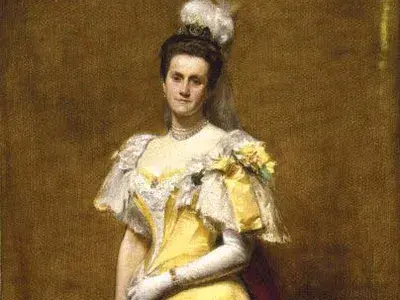Department of She Inspires
We share the diverse stories of women across fields and generations—stories that inspire, give visibility, and empower future changemakers. From trailblazers of the past to leaders today, each story reminds us of the power of representation.
Hedy Lamarr
By Eileen Fu
Her Story
Hedy Lamarr (1914-2000) was an Austrian-American actress and inventor. She rose to fame as a glamorous movie star in the 1930s and 1940s, but also made groundbreaking contributions to science, particularly in the field of wireless communications technology.
As a woman of influence in both Hollywood and the scientific community, Hedy faced severe sexism. Her talent was often overshadowed by her beauty, and she was rarely taken seriously as an inventor. So she fled a controlling marriage and Nazi-occupied Europe to seek freedom and safety in the United States. Despite the obstacles, she continued to pursue her interest in invention privately.
During World War II, Hedy co-invented a “frequency-hopping” system with composer George Ansell. The technology was designed to prevent enemy ships from jamming torpedo guidance signals. While the invention was not used during the war, it laid the foundation for modern technologies such as Bluetooth, GPS, and Wi-Fi.
Although these recognitions came late and mostly posthumously, they certainly affirm the importance of her scientific legacy.
Hedy Lamarr shattered stereotypes about beauty and intelligence. Her creative mind laid the foundation for the technologies that shape our daily lives. She reminded us that perseverance can lead to breakthroughs that change the world.
Achivement
-
Inducted into the National Inventors Hall of Fame (2014)
-
Received the Pioneer Award from the Electronic Frontier Foundation (1997)
International Women in Engineering Day
By Yixuan Li
What is it?
International Women in Engineering Day celebrates the amazing achievements of women engineers around the world and raises awareness about the need for gender diversity in STEM. It’s a reminder that innovation thrives when everyone is included in building the future.
Emily Warren Roebling
After her husband fell ill, Emily Warren Roebling took over much of the day-to-day supervision of the Brooklyn Bridge’s construction, becoming one of the first women to play a key role in a major civil engineering project.

Mary Jackson
As NASA’s first Black female engineer, Mary Jackson broke barriers in both science and society, advocating for equal opportunities in STEM while contributing vital work to the U.S. space program. Her story was spotlighted in Hidden Figures.

Ellen Ochoa
Ellen Ochoa made history as the first Hispanic woman in space and is also a pioneering engineer, holding multiple patents in optical systems. She later served as the Director of NASA’s Johnson Space Center.

Debbie Sterling
Debbie Sterling is the founder of GoldieBlox, a toy company that encourages young girls to explore engineering through storytelling and creativity. She is a passionate advocate for breaking gender stereotypes in STEM from an early age.

Noramay Cadena
An aerospace engineer turned venture capitalist, Noramay Cadena uses her platform to invest in tech startups and champion Latinx representation in STEM fields. Her journey from single teen mom to MIT graduate continues to inspire.

Mae C. Jemison
Mae Jemison is an engineer, physician, and the first Black woman to travel to space aboard the Space Shuttle Endeavour in 1992. A passionate advocate for science education and diversity, she continues to inspire future generations to reach for the stars.
"Don’t let anyone rob you of your imagination, your creativity, or your curiosity."
– Mae Jemison

Katherine Johnson
By Omay Li
Overview
Katherine Johnson (Aug 26, 1918 - Feb 24, 2020) was an American mathematician who played a vital role in NASA missions during the Space Race. Her intelligence and skill with numbers became apparent when she was a child. She started attending high school when she was ten years old.
By the time she was 18, she graduated with highest honors from West Virginia State College (now West Virginia State University). In 1939, she was selected to be one of the first three African American students to enroll in a graduate program at West Virginia State University. She studied math there. soon left because she decided to start a family.
Key Milestones
-
In 1953, she accepted a job as a "computer" for NACA at the Langley Laboratory.
-
In 1958, she was assigned to calculations for the first manned space mission
-
In 1961, she calculated the trajectory for Alan Shepard's Freedom 7 mission, the first American in space.
-
In 1969, she assisted with calculations for the Apollo 11 mission to the Moon.
Later Life
Katherine Johnson retired in 1986, after 33 years at Langley.
In 2015, at age 97, Johnson added another extraordinary achievement to her long list:
President Barack Obama awarded her the Presidential Medal of Freedom, America's highest civilian honor.
Hidden Figures
The film. "Hidden Figures," based on the book by Margot Lee Shetterly, focuses on three African-American women, Katherine Johnson, Mary Jackson, and Dorothy Vaughan, who were essential to the success of early spaceflight.
Works Cited
Preceden. "The Life of Katherine Johnson Timeline." Preceden.com; 2015. Web. 30 June. 2025.
Shetterly, Margot. "Katherine Johnson Biography - NASA." nasa. gov. 23 Nov. 2016. Web. 30 June. 2025.